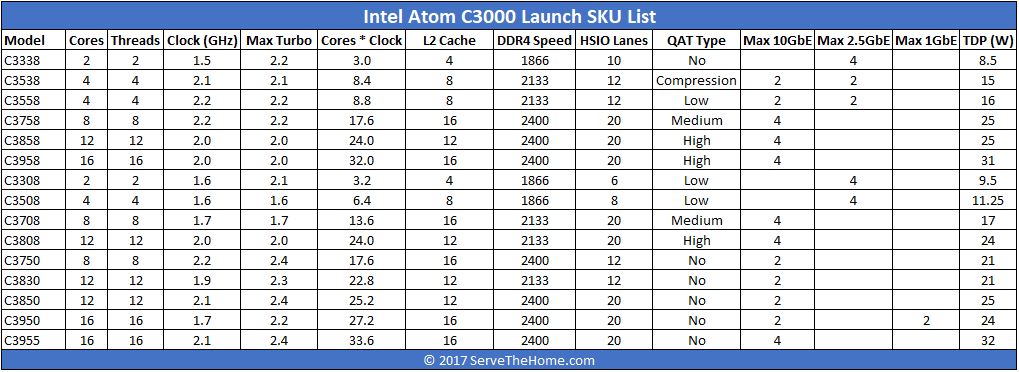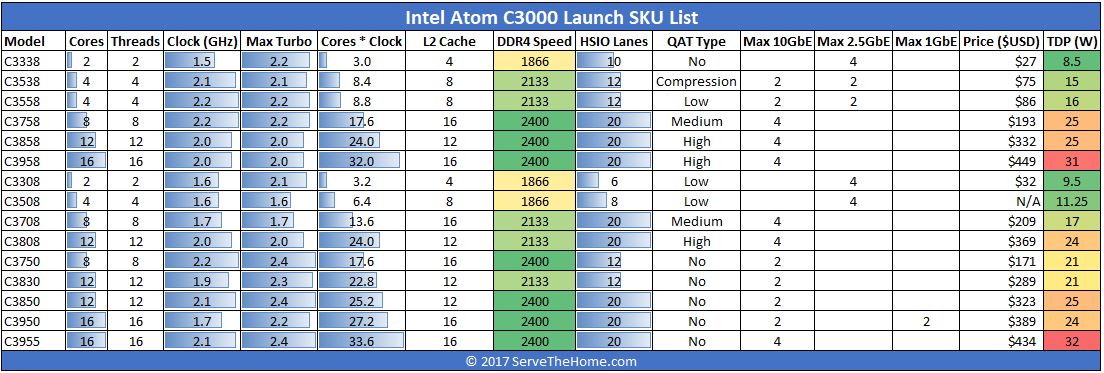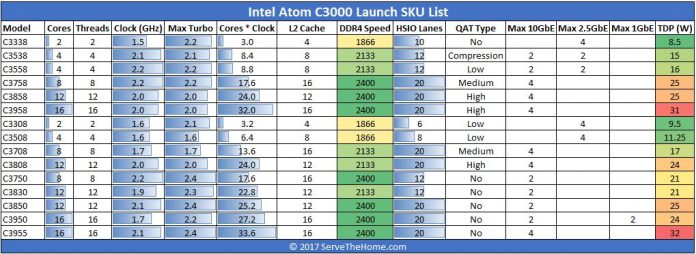The Intel Atom C3000 launch just happened as a very low key affair. As of today, August 15, 2017, the Intel Atom C3000 line is available to OEMs building solutions around the chips. The initial list we received was what we would call preliminary. With embedded parts, it is not uncommon to see the line-up evolve over time. Whereas the previous-generation Intel Atom C2000 series was extremely straightforward, the Intel Atom C3000 offers more points of differentiation.
Intel Atom C3000 Series Launch SKUs
Here are the fifteen Intel Atom C3000 series launch SKUs from the preliminary information we received:

You can see that we have clock speeds of 1.5GHz to 2.2GHz. Memory is between DDR4-1866 and DDR4-2400. We have varying High-Speed I/O (HSIO) lanes. We also have varied core counts, networking, and QAT options. Before we get into the specifics we added a few chart formatting points to help visualize the differences and include recommended pricing:

Armed with this information, let us look at what the differentiations mean beyond CPU cores and clocks.
-
RAM
- DDR4 Speed: Intel is varying the maximum DDR4 speed with 7 of the 15 SKUs able to achieve a maximum of DDR4-2400, 5 of 15 SKUs limited to DDR4-2133 and the remaining 3 SKUs limited to DDR4-1866
- DDR4 Channels: What is not in the chart above, but what we saw in our Intel Atom C3338 review, the three DDR4-1866 SKUs are also limited to single channel DDR4 with up to two DIMMs in that channel. The other SKUs have dual channel and up to two DIMMs per channel (4 DDR4-DIMMs total)
-
HSIO Lanes
- HSIO lanes vary from 6 to 20 depending on the SKU. 8 of 15 SKUs have 20 HSIO lanes.
- HSIO lanes can be used for devices such as SATA III or PCIe devices
- HSIO lane personality can be set in BIOS. If the motherboard has wires, one can re-allocate PCIe lanes to SATA 3 or vice versa
- We do expect power consumption to vary with the number of HSIO lanes enabled
-
QuickAssist Technology (QAT)
- Like with the Intel Xeon Scalable Lewisburg PCH QAT options, the Intel Atom C3000 series will have at least four different QAT variants
- 6 of 15 SKUs are meant to be “compute focused” without QAT. We are bucketing the Intel Atom C3338 in this list due to its QAT
- We expect the QAT to be a different version with different features than on the Intel Atom C2xx8 series “Rangeley” parts
-
Networking
- Networking on the Intel Atom C3000 series still appears to require an external PHY
- There are variants ranging from 4x 10GbE to 4x 2.5GbE
- From what we understand, over 20Gbps worth of networking will require specific packet sizes in order to achieve maximum throughput across all ports
-
Lifecycle and Environmental
- Since the Intel Atom C3000 series is targeted at embedded markets, Intel has three main segments with the following QAT breakdown:
- Network and Enterprise SKUs – QAT on most SKUs
- Extended Temperature SKUs – QAT on all SKUs
- Server and Cloud Storage SKUs – No QAT
- The main life cycle of the families is
- Extended Temperature SKUs – 3-year supply/ 5-year reliability
- Network and Enterprise SKUs – 7-year supply/ 10-year reliability
- Server and Cloud Storage SKUs – 7-year supply/ 10-year reliability
- Since the Intel Atom C3000 series is targeted at embedded markets, Intel has three main segments with the following QAT breakdown:
Final Words
The Intel Atom C3000 series SKU list is certainly more expansive and more complex than the Intel Atom C2000 series was at launch. In general, it shows that Intel has been able to penetrate some key markets that low-end ARM was threatening in the 2013 timeframe.
This differentiation will come at a cost. We will update this piece as we get price lists for the Denverton series. What we can say is expect costs to go up significantly, and not the $18 premium Intel places on dual 10GbE on the Intel Xeon Scalable line.
If you want to learn more, we have complete coverage at our Denverton Day Official STH Intel Atom C3000 Launch Coverage Central





Hmm, interesting. It looks like the larger die (12-core and 16-core SKUs) only has 1MB of L2 per core while the smaller (up to 8-core) die has 2MB of L2 per core. I’m assuming they’re separate dies anyway; it would make sense for Intel to do so.
Can you please run some single-threaded benchmarks comparing the higher core count and lower core count chips at about the same clockspeed? My gut feeling is that extra L2 is pretty significant.
Will see what we can do when we get the lower core count parts in the lab (other than the C3338)
BTW.. if anyone is wondering like me what the QAT types are this is what I managed to glean from http://hexus.net/tech/news/cpu/109174-intel-publishes-atom-c3000-processor-family-product-brief/ :
Compression = Up to 5 Gbps, compression only
Low = Up to 5 Gbps
Medium = Up to 10 Gbps
High = Up to 20 Gbps
Sweet. With a price of £264+VAT looks like the A2SDi-4C-HLN4F (C3558) will be my next firewall/router/VPN.